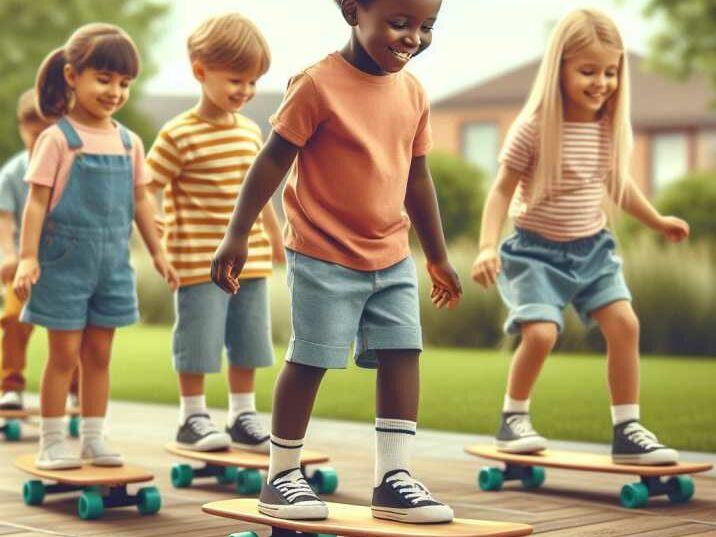Balancing Games for Kids
Table of Contents
Introduction:
Balancing games refer to a variety of activities designed to enhance a person’s ability to maintain equilibrium and stability. These games are particularly popular among children for both recreational and developmental purposes. Balancing games typically involve physical exercises that challenge individuals to distribute their weight evenly, improve coordination, and develop core strength. These activities are not only enjoyable but also contribute to the overall physical and cognitive development of individuals, especially children.
In a world inundated with screens and digital distractions, finding ways to make physical activities enjoyable for kids has become imperative. Balancing games for kids offer a perfect solution, blending fun and education seamlessly. This article delves into the exciting realm of balancing games, providing parents and educators with a comprehensive guide on making training both fun and educational.
The Importance of Balancing Games for Kids
Balancing games for kids are not just a source of entertainment; they play a crucial role in a child’s development. As kids engage in these activities, they enhance their motor skills, coordination, and spatial awareness. Moreover, the cognitive benefits extend to improved focus, concentration, and problem-solving abilities. Let’s explore some exciting balancing games that can transform training into a delightful experience for kids.
Tightrope Walking Adventure
Encourage your little ones to imagine a circus tightrope walker as they navigate a straight line or a drawn rope on the ground. This game enhances balance and concentration, all while fueling their creativity.

Egg and Spoon Challenge
Transform the classic egg and spoon race into a balancing game. Kids learn to balance the egg on the spoon while navigating obstacles, providing a fantastic combination of coordination and fun.
Creating a Fun and Educational Training Environment
Ensuring that training is not only beneficial but also enjoyable is essential. Parents and educators can follow these tips to make the learning process engaging and effective.
Integrate Educational Themes
Incorporate educational themes into balancing games. For example, create a game where kids balance on a pretend pirate ship while solving math problems or answering trivia questions.
Use Colorful Props
Add vibrancy to the training environment by using colorful props. Mats, cones, and markers can be visually stimulating, capturing the attention of kids and making the learning experience more enjoyable.
Pirate Ship Adventure:
This imaginative game combines storytelling with balancing activities. Children might balance on a “pirate ship” while engaging in problem-solving activities or answering educational questions.
Balance Board Games:
Specialized balance boards or discs are used to challenge individuals to maintain stability while standing or performing specific exercises.
Yoga Balancing Poses:
Various yoga poses focus on balance, requiring individuals to hold specific positions that challenge their stability and concentration.

Balancing games for kids offer a holistic approach to physical and cognitive development. They improve motor skills, coordination, spatial awareness, and core strength. Additionally, these games can be adapted to incorporate educational elements, making learning a fun and interactive experience for children.
Parents, educators, and physical therapists often integrate balancing games into routines to encourage a healthy and active lifestyle while fostering essential skills in individuals, especially during their formative years. These activities are not only enjoyable but also contribute to the overall well-being and development of individuals across different age groups.
Information-Based Table: Top 5 Balancing Games for Kids
| Game Name | Benefits | Age Group | Materials Required |
|---|---|---|---|
| Tightrope Walking | Enhances balance and concentration | 4-8 years | Chalk or rope |
| Egg and Spoon Challenge | Develops coordination and motor skills | 6-10 years | Spoons, eggs, and obstacles |
| Pirate Ship Adventure | Combines balance with problem-solving activities | 5-9 years | Mats and educational props |
| Obstacle Course Fun | Improves agility and spatial awareness | 7-12 years | Cones, hurdles, and markers |
| Balancing Beam Bonanza | Strengthens core muscles and improves coordination | 8-14 years | Wooden beam or plank |
Conclusion:
In conclusion, integrating balancing gamesfor kids’ training routines is a powerful way to make learning enjoyable and educational. These games not only enhance physical and cognitive skills but also contribute to a child’s overall development. By following the tips provided and exploring the suggested games, parents and educators can create a dynamic and engaging training environment for kids.

Frequently Asked Questions (FAQs)
Q1: Why are balancing games important for kids?
A1: Balancing games help improve motor skills, coordination, and cognitive abilities in children. They contribute to overall physical and mental development.
Q2: How can I make balancing games educational?
A2: Integrate educational themes, use colorful props, and incorporate problem-solving activities within balancing games to make them educational and fun.
Q3: Are balancing games suitable for all age groups?
A3: Yes, there are balancing games designed for various age groups, ensuring age-appropriate challenges and benefits.
Q4: What materials are needed for balancing games?
A4: Materials vary based on the game but may include ropes, mats, cones, eggs, and spoons, among others.
Q5: Can balancing games be played indoors?
A5: Yes, many balancing games can be adapted for indoor play, ensuring year-round engagement.
Q6: How can I ensure my child’s safety during balancing games?
A6: Choose age-appropriate games, provide proper supervision, and create a safe playing environment to ensure your child’s safety.
Q7: Can balancing games improve academic performance?
A7: Yes, the cognitive benefits of balancing games, such as improved focus and problem-solving skills, can positively impact academic performance.
Q8: Are there balancing games suitable for group play?
A8: Absolutely, many balancing games can be adapted for group play, promoting teamwork and social interaction.
Q9: How often should balancing games be incorporated into a child’s routine?
A9: Balancing games can be included in a child’s routine a few times a week to ensure consistent development of motor and cognitive skills.
Q10: Are there virtual or online balancing games for kids?
A10: Yes, there are virtual balancing games available that provide a screen-based alternative for kids.
Q11: Can balancing games be therapeutic for certain conditions?
A11: In some cases, balancing games may be recommended as part of therapy for conditions affecting motor skills and coordination.
Q12: Where can I find more information on balancing games for kids?
A12: Explore reputable educational websites, parenting blogs, and consult with educators for a wealth of information on balancing games tailored for kids.


